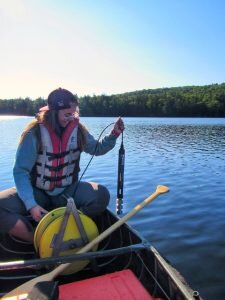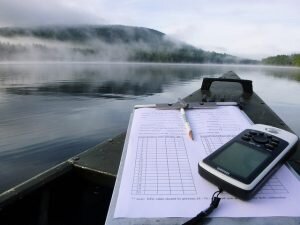
Adirondack Lake Assessment Program (ALAP)
A joint project between Protect the Adirondacks and the Paul Smith's College Adirondack Watershed Institute
There are over 3,000 lakes in the Adirondack Park, with fewer than 200 being monitored on a regular basis. Monitoring is important for understanding how lakes change over time, and is particularly valuable for developed lakes. The continued enjoyment of these lakes by property owners and visitors is heavily dependent on water quality, as is the value of shoreline property. Lake monitoring helps protect this resource we value so much.
The Adirondack Lake Assessment Program (ALAP) was established in 1998 to provide water quality data to shoreowners and to develop a comprehensive, long-term database of water quality conditions in the Adirondack Park. ALAP is the largest volunteer-driven water quality monitoring program in the Adirondack Park, and is a partnership between Protect the Adirondacks (PROTECT) and the Paul Smith’s College Adirondack Watershed Institute (AWI), along with more than 200 volunteers across the Adirondacks.
The information collected as part of ALAP is used to identify causes of concern that may need action (e.g. faulty septic systems) and to conduct regional analysis to understand various stressors that impact our waters. For example, ALAP data was used to assess the effects of road salting on lakes in a paper that formed the scientific basis for discussions with state and local officials on curbing the use of road salt to protect our environment.
How ALAP Works?
Participation in ALAP is easy. ALAP volunteers sample their lakes for three-month or five-month periods. (Parties interested in enrolling should contact Claudia Braymer at Protect the Adirondacks or Sara Kelly at the Adirondack Watershed Institute to discuss which sampling period would be best for them.) Each month participants measure the transparency of their lake with a secchi disk, collect a bottle of water to be analyzed for various chemical components, and filter a small sample of water for chlorophyll determination. The filter and water samples are kept frozen until they are transported to the AWI laboratory at Paul Smith’s College. Training for water quality measurement and sample collection is provided by PROTECT and AWI to volunteers prior to the start of their monitoring program.
Water samples are analyzed by AWI staff for pH, alkalinity, conductivity, color, nitrogen, total phosphorus, chlorophyll-a, transparency, chloride, sodium, and calcium. The results of analyses are written into a report and provided to the public. With this information, lake shore associations, landowners, community groups and government leaders are more informed to make decisions about the future of their waterways.
Participant Resources for 2025: Important Dates and Information
Here are important dates and information to assist ALAP volunteers in monitoring their lakes in 2025.
If you are interested in adding a new lake to add to our database, please contact us in the comment box below to make arrangements. Or, register using our enrollment form by April 15, 2025. We will host training prior to the start of the 2025 sampling season.
Here’s important information for water testing in 2025:
2025 Sample Delivery System: To maintain data quality and laboratory efficiency, it’s important that we get each month’s sample to the AWI lab promptly by the dates below. The lab is staffed and equipped for analysis on certain days. We are not able to process samples that are not delivered on time.
2025 Sample Drop Locations: We will use four sample drop locations in the summer of 2025:
Paul Smith’s College – Hours Monday-Friday 8-4:30 (freezer located outside, samples can be dropped at any time) Adirondack Watershed Center Institute/Poalozzi Center. Click here for directions Paul Smith’s College. Please contact Sara Kelly at AWI if you have questions: phone (518) 327-6054 or email at skelly1@paulsmiths.edu.
North Creek – Freezer location has changed. The new location is 105 Oven Mountain Road in Johnsburg. This address is 5 minutes from the Route 28/Route 8 intersection. The freezer is located outside the building by the garage door. The office is .5 miles from Route on Oven Mountain Road (large brown domes with a large solar array). The phone number is 518-251-2700.
Blue Mountain Lake – Freezer is located in a brown garage at 3339 NYS Route 28. This is on the north side of the road, 0.9 mile west from the intersection of Route 28 and 30. Call 518-352-7627 if you have questions.
Keeseville – 419 Frontage Road. The driveway has a sign for a "Yoga Studio" and a large "peace" sign. Turn into driveway, travel 50 yards, turn right and travel another 50 yards and see giant solar platform with lots of machinery parked underneath it. The freezer is on the right side, plugged into the wall.
***Please note: If none of these drop off locations work for you, contact Claudia Braymer at Protect the Adirondacks at 703-937-7163 to make specific arrangements .
2025 Sample Pickup: We are developing a sample pickup program to ensure speedy and timely delivery to the lab at Paul Smith’s College.
2025 Sampling Schedule: In the 2025 sampling season, we need to get all volunteers to perform their monthly samples during the same week each month and deliver them to the Sample Drop Location at the same time. Below are the sampling and sample delivery dates:
5-Month Sampling Season:
Sample between May 16th-25th (samples delivered to drop location/picked up by May 26th)
Sample between June 13th-22nd (samples delivered to drop location/picked up by June 23rd)
Sample between July 11th-20th (samples delivered to drop location/picked up by July 21st)
Sample between August 8th-17th (samples delivered to drop location/picked up by August 18th)
Sample between September 5th-14th (samples delivered to drop location/picked up by September 15th)
3-Month Sampling Season:
Sample between June 13th-22nd (samples delivered to drop location/picked up by June 23rd)
Sample between July 11th-20th (samples delivered to drop location/picked up by July 21st)
Sample between August 8th-17th (samples delivered to drop location/picked up by August 18th)
What Does Monitoring Cost?
3-months of sampling (June thru August) at one station in a lake costs $250 and 5-months of sampling (May thru September) costs $350. Testing kits cost $400, but only need to be purchased once or can be shared with another monitor. Kits consist of a Secchi disk to measure water transparency, an integrated sampler and bottles for collecting samples for phosphorus, and filtering apparatus and bottles for chlorophyll-a samples. Annual sample bottles and filters are distributed by Protect the Adirondacks every spring.
This is a very inexpensive, though professional, monitoring system because volunteers do the sampling all over the Adirondack Park, saving the scientists a tremendous amount of time and vehicle costs. AWI compiles an annual report each winter summarizing water quality trends in each lake. When a lake’s annual report indicates a troublesome trend, a scientist from AWI will visit and speak with lake associations and/or monitors to consider what should be done to reverse the trend.
Contact Us
The best way for current volunteers to contact us with questions, or for people who are interested in joining the program, is to use this contact form:
Cover photo of Lower Saranac Lake provided by Brendan Wiltse.


